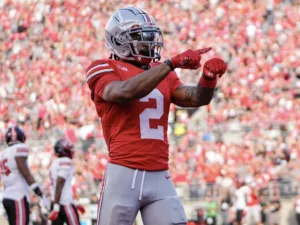
Tight Ends: Can College Yardage Help Predict NFL Success?
When evaluating talent for the NFL, analysts often look at a player’s college performance to predict their professional success. In our 64-part


Sack rates in the NFL are a vital metric often overlooked in the analysis of a quarterback’s performance and potential for success. This statistic measures the frequency with which a quarterback is sacked per pass attempt. Not only does it highlight the quarterback’s ability to evade pressure, but it also reflects the efficiency of the offensive line and the QB’s decision-making skills under duress. With defenses becoming faster and more complex, understanding the significance of sack rates has never been more important.
At the forefront of this discussion are several quarterbacks who have maintained low sack rates since 2014. Among these elite talents are Patrick Mahomes, Jared Goff, Derek Carr, Justin Herbert, Trevor Lawrence, Tua Tagovailoa, and Josh Allen. Their ability to maintain low sack rates contributes to their teams’ offensive successes and their individual prowess on the field.
Patrick Mahomes, known for his dynamic playmaking ability and improvisational skills, naturally excels in avoiding sacks. His ability to extend plays without succumbing to sacks is unmatched, making him a nightmare for defensive coordinators.
Jared Goff and Derek Carr, although possessing contrasting playing styles, share a common proficiency in quick decision-making and release. This quality significantly reduces their sack rates, enabling their offenses to maintain rhythm and momentum.
Justin Herbert and Josh Allen combine their physical prowess with an acute awareness of the field. Their capability to evade defenders and make smart decisions on the fly keeps their sack rates impressively low.
Trevor Lawrence and Tua Tagovailoa, despite being early in their careers, have shown flashes of brilliance in this aspect. Their collegiate success in minimizing sack rates has translated well into the professional level, pointing to a promising future.
Contrary, Towards the bottom of the list (the highest sack rates) are the names of Tyrod Taylor, Daniel Jones, Deshaun Watson, and Blaine Gabbert. Clearly just based off of these names it can be acknowledged that sack rates have a correlation to sustained success.
The correlation between low sack rates and quarterback success is evident when considering the careers of these quarterbacks. Avoiding sacks means fewer lost yards, fewer injuries, and more opportunities to make positive plays. It leads to better game tempo control, less wear and tear on their body, and a greater chance to score.
Moreover, a quarterback with a low sack rate often indicates a well-coordinated team between the offensive line and receivers. It reflects a quarterback’s pre-snap intelligence to identify blitzes and adjust protection, as well as post-snap agility and mental quickness to evade pressure and make successful throws.
In summary, while sack rates are just one of the many metrics to gauge a quarterback’s effectiveness, their importance cannot be overstated. As demonstrated by the likes of Mahomes, Goff, Carr, Herbert, Lawrence, Tagovailoa, and Allen, excelling in this aspect can significantly influence a quarterback’s career trajectory and, ultimately, their likelihood of success in the NFL.
What 3 metrics matter the most when scouting a rookie Quarterback? What threshold should Quarterbacks achieve within those metrics to be considered an elite prospect? How much should you value those stats above all other stats? Couldn't answer those questions? Rest easy, we have it handled for you. That's what this chart answers. Sort by importance and/or filter by position. Unlock by signing up with the links provided. $9.99/Year or $24.99 Lifetime access. Cancel anytime.


Related Content:

When evaluating talent for the NFL, analysts often look at a player’s college performance to predict their professional success. In our 64-part

In our 63-part analytical series, “Does It Matter?”, we next wanted to look into the intriguing question of whether a Tight End’s

For our 61 part “Does It Matter?” series, we looked into whether a Wide Receiver’s College Yards After Catch per Reception (YAC/Rec)
© 2023 BrainyBallers | All Rights Reserved